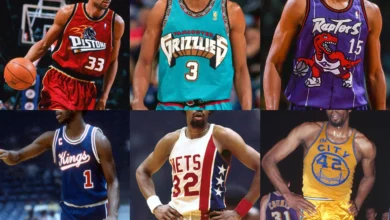The Unsuccessful Draft Pick: How to Avoid the Pitfalls

Every sports team dreams of landing the next superstar through the draft – a player who will lead them to victory, bring fans to their feet, and secure championships. But for every success story, there are tales of teams who missed the mark with an unsuccessful draft pick. In this blog post, we delve into the pitfalls that can plague teams during the drafting process and explore strategies to avoid making costly mistakes. Join us as we uncover the secrets behind successful draft picks and learn how you can steer clear of being another cautionary tale in the world of sports drafts.
The Importance of a Successful Draft Pick
Securing a successful draft pick is like striking gold in the world of sports. It can be the difference between mediocrity and greatness, shaping the trajectory of a team for years to come. A well-chosen player can inject talent, passion, and energy into a roster, captivating fans and driving ticket sales. Beyond immediate impact, a successful draft pick lays the foundation for long-term success by fostering team chemistry and stability.
The ripple effects of a great draft pick extend far beyond the playing field – they can elevate an entire franchise’s reputation, attracting top free agents and lucrative sponsorship deals. Teams that consistently nail their drafts are often contenders year after year, enjoying sustained success that builds dynasties in the annals of sports history.
Case Studies of Unsuccessful Draft Picks
Every sports team dreams of striking gold with their draft picks, but reality can be harsh. Take the case of Player X, a highly touted prospect with all the physical tools but lacked the mental toughness to succeed at the professional level. Despite high expectations, Player X failed to live up to his potential and faded into obscurity.
Then there’s Team Y, known for taking risks on raw talent with questionable character issues. Their gamble backfired when multiple off-field incidents derailed their top pick’s career before it even took off. The lesson learned? Character matters just as much as skill when evaluating draft prospects.
And let’s not forget about Organization Z, notorious for ignoring red flags in favor of flashy stats. Their fixation on numbers blinded them to glaring weaknesses in their pick’s game, leading to disappointment and regret down the line. Remember: stats can only tell part of the story; scouting and intangibles are equally crucial in making successful draft decisions.
Common Mistakes Made by Teams in the Draft Process
The excitement of the draft can often lead teams to overlook crucial factors in their decision-making process. One common mistake is focusing too much on a player’s physical attributes without considering their character and work ethic. Teams may also fall into the trap of selecting players based solely on hype or potential, rather than proven performance.

Another pitfall is neglecting to thoroughly research a prospect’s injury history or off-field behavior, which can have significant repercussions down the line. Additionally, failing to assess how a player will fit within the team’s existing system and culture can result in a mismatch that hinders both the player and the team’s success.
Rushing decisions without taking the time to gather input from all relevant parties, including coaches, scouts, and analytics staff, can lead to shortsighted picks that do not align with long-term goals. It’s essential for teams to approach each draft pick with careful consideration and comprehensive evaluation.
Strategies to Avoid Unsuccessful Draft Picks
When it comes to avoiding unsuccessful draft picks, teams must be diligent in their approach. One key strategy is conducting thorough research on potential prospects. This includes analyzing player performance, character traits, and injury history.
Teams should also prioritize communication among scouts, coaches, and front office staff. Collaborating and sharing insights can help paint a clearer picture of each prospect’s fit within the team’s system.
Another effective strategy is to trust the scouting process while also incorporating advanced analytics. By combining traditional scouting methods with data-driven analysis, teams can make more informed decisions on draft day.
Furthermore, it’s essential for teams to consider long-term potential over short-term gains. Building a successful team requires looking beyond immediate needs and focusing on developing talent for sustained success.
In addition, maintaining flexibility during the draft allows teams to adapt to unforeseen circumstances or opportunities that may arise. Being able to pivot based on new information or trade possibilities can prevent costly mistakes in the selection process.
Employing a comprehensive approach that blends research, collaboration, data analysis, long-term planning, and flexibility is crucial in steering clear of unsuccessful draft picks.
The Role of Scouting and Analytics in the Draft Process
Scouting and analytics play a crucial role in the draft process, helping teams make informed decisions on potential picks.
Scouts are the eyes and ears of the organization, attending games, evaluating players’ skills, character, and potential fit within the team. Their insights provide valuable information for decision-makers.
On the other hand, analytics offer a data-driven approach to player evaluation. By crunching numbers and analyzing statistics, teams can uncover hidden gems or red flags that might not be apparent through traditional scouting alone.
Combining both scouting expertise with analytical tools gives teams a comprehensive view of prospects. It’s like having a full picture instead of just puzzle pieces scattered around.
Successful organizations understand the importance of balancing these two aspects to make smart draft choices that align with their long-term goals. In today’s competitive sports landscape, leveraging both scouting and analytics is essential for staying ahead in the game.
Lessons Learned from Successful Draft Picks
Lessons learned from successful draft picks go beyond just talent evaluation. It’s about understanding the intangibles that make a player thrive in a team environment. One key lesson is the importance of character assessment – identifying players with strong work ethic, leadership qualities, and coachability.
Successful teams also prioritize fit within their system. It’s not just about drafting the best player available but selecting someone who complements existing strengths and addresses team needs. Flexibility is crucial – being able to adapt strategies based on evolving circumstances can lead to long-term success.
Embracing analytics alongside traditional scouting methods can provide a more comprehensive view of a prospect’s potential. Finding the right balance between stats and subjective evaluations can uncover hidden gems overlooked by others.
Successful draft picks teach us that it takes a combination of foresight, adaptability, and thorough evaluation to build a winning team for years to come.
Conclusion
In the fast-paced world of professional sports, the draft process plays a crucial role in shaping the future success of teams. Avoiding unsuccessful draft picks is essential for building a strong and competitive roster. By learning from past mistakes, implementing effective strategies, utilizing scouting and analytics effectively, and drawing inspiration from successful draft picks, teams can increase their chances of making successful selections.
Remember that even the most seasoned scouts and front office personnel make errors in judgment when evaluating players. However, by being diligent and thorough in the evaluation process while also taking calculated risks, teams can minimize the likelihood of selecting an unsuccessful draft pick.
Avoiding pitfalls in the drafting process requires a combination of expertise, careful analysis, strategic planning, and a bit of luck. With these elements in place and a commitment to continual improvement, teams can increase their odds of finding hidden gems and building winning rosters for years to come.



